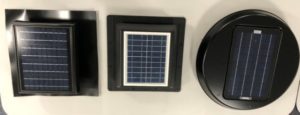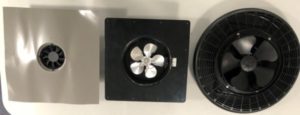Whirlybirds Full Guide: Pros, Cons, and The Best Alternative
When it comes to roof ventilation, many Australian homeowners turn to whirlybirds to help reduce heat buildup in their homes. But how effective are they? In this guide, we’ll explore the pros and cons of whirlybirds and introduce a more advanced alternative: the Solar Star.
What Is a Whirlybird & How Does It Work?
A whirlybird is a traditional roof ventilation device commonly used in Australian homes. Its primary function is to extract hot air from roof spaces, which can accumulate in attics or ceilings and cause the entire house to heat up. Whirlybirds are powered by wind—when the wind blows, the device spins, and this motion helps draw out the warm air trapped in the roof cavity.
While whirlybirds can provide some relief from heat, their effectiveness largely depends on external conditions. If there is little or no wind, the whirlybird remains idle, meaning it may not always perform when needed most. Additionally, the rate of air extraction is typically low, which can limit its ability to cool larger spaces.
The Advantages of Whirlybirds
Whirlybirds do have several advantages that have contributed to their widespread use:
- Low Cost: One of the biggest selling points of whirlybirds is their affordability. They are often a cost-effective option for roof ventilation.
- Easy Installation: They can be installed relatively quickly by most roof professionals, with minimal modifications to the roof.
- Low Maintenance: Whirlybirds usually require little upkeep, making them convenient for many homeowners.
However, it’s important to note that while whirlybirds may seem like a budget-friendly solution, their low cost often comes with compromises in performance.
The Disadvantages of Whirlybirds
Despite their popularity, whirlybirds come with several drawbacks that may limit their effectiveness in certain environments:
1. Low Efficiency
The primary issue with whirlybirds is their reliance on wind to function. On days with no wind, or very low wind speeds, whirlybirds are unable to spin and effectively extract hot air. This leaves homes prone to heat buildup during the hottest, calmest days, when ventilation is needed most.
2. Limited Airflow
Whirlybirds typically have a low air extraction rate, meaning one or two units may not be sufficient for larger homes or roof spaces. To achieve proper ventilation, multiple whirlybirds may be needed, which can increase costs and clutter the roof.
3. Noise
When wind speeds pick up, some homeowners report a loud, persistent whirring sound as the whirlybird spins at high speed. This noise can be disruptive, especially at night, leading to a less comfortable living environment.
4. Aesthetics
Whirlybirds, though functional, may not be visually appealing. Their bulky, spinning design can stand out on rooftops, detracting from the overall look of a home. Some homeowners may prefer a more streamlined or subtle roof ventilation solution.
Introducing Solatube’s Solar Star: The Best Alternative to Whirlybirds in The Market
If you’re looking for a more reliable and efficient roof ventilation solution, Solatube’ s Solar Star is the superior alternative to whirlybirds. Powered by solar energy, the Solar Star provides continuous ventilation throughout the day, regardless of wind conditions. Its whisper-quiet operation, high-performance motor, and sleek design make it an ideal option for modern homes.
The Solar Star’s solar panel captures sunlight to power the motor, which drives a fan to actively extract hot air from the roof space. This design ensures optimal airflow and better temperature regulation, helping keep your home cooler, especially during hot summer months. Unlike whirlybirds, Solar Star works consistently without being dependent on external weather factors, making it a far more effective choice.
Roof Ventilation Alternatives VS The Solatube Solar Star


Why Choose Solar Star Roof Ventilation Over Traditional Whirlybirds?
- Longer Lifespan: The Solar Star is built with high-quality components designed to withstand harsh weather conditions, making it more durable than traditional whirlybirds. With fewer moving parts and no reliance on wind, the Solar Star offers a longer operational lifespan and less wear and tear.
- Better in Australian Climates: Tested specifically for Australian conditions, the Solar Star performs exceptionally well even during extreme heat and on windless days. Whether it’s the peak of summer or a calm, breezeless day, Solar Star provides consistent ventilation.
- Maintenance-Free: Unlike whirlybirds, which may require occasional servicing to address noise or wear and tear, Solar Star is completely maintenance-free. Once installed, you can enjoy effective roof ventilation without the hassle of upkeep or repairs.
Here is a demonstration of the Solar Star compared to a common Whirlybird.
The Solar Star Offers High Performance No Matter the Weather
The Solar Star performs well even in poor weather conditions. Take a look at how well it works when it’s pouring rain!
Frequently Asked Questions about Whirlybirds
Do whirlybirds work?
While whirlybirds can provide some ventilation, Solatube’s Solar Star product offers a more efficient and effective solution. It utilises solar power and its advanced design results in optimal roof space airflow. Additionally, Solar Star has a considerably slimmer design, making them suitable for more roof designs than the average whirlybird.
Are whirlybirds effective?
Whirlybirds can provide basic roof space ventilation, but they may not be as effective as Solatube’s Solar Star. Without the correct temperatures, a whirlybird will still leave your attic full of warm, moist air. Also, whirlybirds always require a temperature differential to spin their turbines and extract the air from your space. The Solar Star, on the other hand, offers superior airflow and energy efficiency, keeping your roof space cooler.
Are whirlybirds worth it?
Whirlybirds can be a budget-friendly option if you’re looking for ventilation only. However, for long-term performance and energy savings, we suggest you consider Solatube’s Solar Star ventilation. It offers superior functionality and can be a worthwhile investment to improve property value.
How many whirlybirds do I need for effective ventilation in a large home?
The number of whirlybirds depends on the size of your roof space and the ventilation required. For larger homes, multiple units may be necessary, which can increase installation costs.
Can whirlybirds operate at night?
Whirlybirds rely on wind, not electricity, to function. If there’s wind at night, they will continue to operate, but if there’s no wind, they will not provide ventilation.
Are whirlybirds noisy?
Whirlybirds can be noisy, especially when spinning at high speeds during windy conditions. This noise can be bothersome for some homeowners.
How do whirlybirds compare to solar-powered ventilators like the Solar Star?
Solar-powered ventilators like the Solar Star provide consistent, reliable ventilation regardless of wind conditions. They also tend to be quieter and more efficient than Whirlybirds. In conclusion, while whirlybirds offer a low-cost ventilation solution, they come with limitations in efficiency, airflow, and aesthetics. For those seeking a more reliable, long- lasting, and efficient alternative, Solatube’ s Solar Star is the clear choice for modern roof ventilation.
